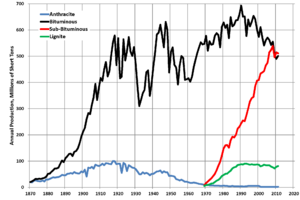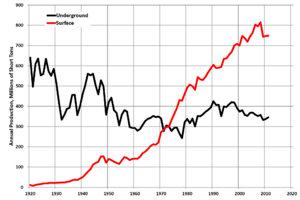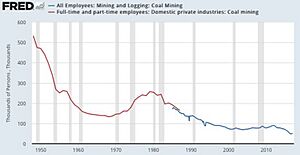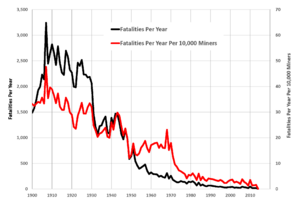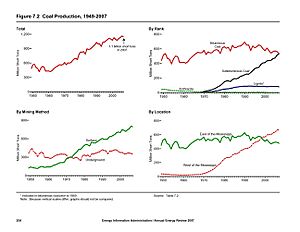History of coal mining in the United States facts for kids

The history of coal mining in the United States began in 1701 in Richmond, Virginia. Coal quickly became the main power source in the late 1800s and early 1900s. Even though its use is now decreasing, coal is still an important energy source today.
Coal became the biggest energy source in the 1880s, taking over from wood. It remained number one until the early 1950s, when oil became more widely used. From the 1880s to the 1940s, coal provided more than half of the nation's energy. Between 1906 and 1920, it supplied over three-quarters of all energy in the US.
Contents
How Coal Mining Grew in the 1800s
At the start of the 1800s, most coal mining involved bituminous coal, also known as "soft coal." In 1810, about 176,000 short tons of soft coal were mined, along with 2,000 tons of anthracite (hard coal). American coal mining grew very fast in the 1820s, often doubling or tripling every ten years.
Hard coal mining became more common than soft coal mining in the 1840s. From 1843 to 1868, more hard coal was mined. However, there wasn't as much hard coal available. So, from 1869 onwards, soft coal became the main type of coal mined again. Also, hard coal was used less in making iron because coke, made from soft coal, worked better in large furnaces after the Civil War.
Hard coal mining started before the War of 1812. It burned cleanly with little smoke, making it a popular fuel in cities. It replaced wood as a main fuel around 1850. Hard coal from northeastern Pennsylvania and later West Virginia was also used in early factories. Many major railroads built lines into the hard coal fields. By 1840, over a million short tons of hard coal were mined each year. This amount quadrupled by 1850, helping to boost railroad building, mining, and steel production.
After 1850, soft coal, which was cheaper but dirtier, became popular for railway engines and steam engines. It was also used to make coke for steel production after 1870.
How Government Policies Helped Coal Mining
The US government saw coal as very important for the country's future. Congress made rules to help American coal miners by adding taxes on foreign coal. State governments also helped by doing surveys to find new coal areas. These actions helped coal mining grow quickly. By the 1870s, the US was even selling coal to other countries.
Pennsylvania was a leader in coal production. It didn't tax hard coal and encouraged its use in the iron industry. Many states also looked for new coal fields. Pennsylvania produced three-fourths of all US coal by 1850.
Railroads and Coal in the Late 1800s
In the late 1800s, railroad companies became very powerful in the hard coal industry. They bought coal lands and set prices. Government efforts to control them didn't work very well. The main goal was to keep coal production high and find new coal fields. For example, the United States Geological Survey was created in 1879 to find valuable minerals.
Workers' Rights and Unions
Before the Civil War, coal mining was small-scale. Skilled miners often worked like independent contractors. But as companies grew, they pushed to mine more coal and cut costs. This meant miners faced lower pay, deductions for impurities in coal, and sometimes were paid in company money instead of cash.
Small unions formed in different coal areas to fight for better wages. But coal companies tried hard to stop unions from organizing. In 1890, a national union called the United Mine Workers of America (UMWA) was formed. For the next 50 years, the UMWA worked to get fair agreements for miners across the country.
Coal Mining in the 1900s
In the early 1900s, the government started to get involved in coal mining because of worker strikes and railroads trying to control prices. The big Coal strike of 1902 in the hard coal fields almost cut off fuel for many homes and businesses. This led President Theodore Roosevelt to step in. He called for a "square deal" between workers and companies. This didn't force companies to work with unions, but it did mean the government would watch over things.
The United States Bureau of Mines was created in 1910 to make sure mines were safe. The government wanted to keep coal production high while also protecting workers.
Strikes were very common. Even though miners often earned good wages, they used strong words to show they felt unfairly treated. Miners who were unhappy could either move to another mine or join the union to fight for changes.
Total coal production grew a lot until 1918. It doubled every ten years before 1890. It went from 8.4 million short tons in 1850 to 270 million in 1900, and peaked at 680 million short tons in 1918. New soft coal fields opened in states like Ohio, Indiana, Illinois, West Virginia, Kentucky, and Alabama. The Great Depression in the 1930s caused demand to drop to 360 million short tons in 1932.
Coal Mining Today
By 2014, most coal mining had moved to open-pit mines in Wyoming. There were only about 60,000 active coal miners. The UMWA union had only 35,000 members, with 20,000 still working, mostly in underground mines in Kentucky and West Virginia. This is a big change from the late 1930s, when the union had 800,000 members.
In 2015, the American coal industry faced challenges. New environmental rules, efforts by activists, lower coal prices, and cheaper alternative fuels all played a part. Rules from the Environmental Protection Agency limited power plant carbon emissions. This pushed power plants to use natural gas and other energy sources instead of coal. Several major coal companies went bankrupt, showing the tough times for the industry.
Coal Mining in Different States
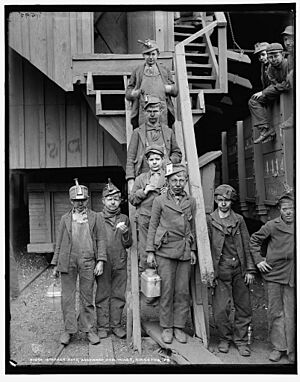
Pennsylvania's Coal Story
- The first hard coal was mined in 1768 in the Wyoming Valley (Kingston, PA).
- A map from 1770 showed five coal mines in Schuylkill County.
- By 1807, the Smith Brothers were selling 50 tons of coal from Plymouth, Pennsylvania. They sent it by boat down the Susquehanna River.
- In 1808, Jesse Fell from Wilkes-Barre found a way to burn hard coal in simple open-air fireplaces, making it useful for homes.
- Soft coal was first mined in Pennsylvania at "Coal Hill" (Mount Washington), near Pittsburgh. Miners used canoes to transport it to the nearby military base. By 1830, Pittsburgh used over 400 tons of soft coal daily for homes and factories.
The Lackawanna Valley in Pennsylvania had lots of hard coal and iron. In 1840, brothers George W. Scranton and Seldon T. Scranton moved to Slocum's Hollow (now Scranton) to build an iron factory. They used a new method called "hot blast" and also used hard coal to make steel, instead of charcoal or soft coal.
West Virginia's Coal History
In the 1880s, many European immigrants and African Americans came to southern West Virginia to work in coal mines. Miners often worked for company mines, using company tools and living in company housing. They had to pay for these things, and sometimes were paid in company money that could only be spent at company stores.
Safety in the mines was a big worry. West Virginia had a higher death rate in mines than any other state between 1890 and 1912. The state was also the site of the worst coal mining disaster in history, the Monongah Mining disaster in 1907. This accident was caused by methane gas and coal dust exploding, killing 362 men. This disaster led the United States Congress to create the Bureau of Mines to improve safety.
Kentucky's Coal Story
In the early 1900s, coal mining grew fast in eastern Kentucky. As factories across the US needed more coal, big companies invested in mines there. New machines and explosives made mining faster but also more dangerous. Mining disasters, like the Harlan County disaster in 1976, were common and caused many deaths.
Coal mining was a major industry in eastern Kentucky throughout the 1900s, providing jobs and helping the economy. However, it also harmed the environment and people's health. Strip mining and mountaintop removal destroyed forests and habitats. Pollution from coal power plants led to more breathing problems for local people.
In the 2000s, coal mining in eastern Kentucky has slowed down. This is because of competition from Wyoming, power plants switching to natural gas, and more use of renewable energy. Many mining towns have faced economic struggles. Efforts are now being made to find new types of jobs in the region.
Diana Baldwin and Anita Cherry were the first women to work inside an American coal mine. They started in 1973 in Jenkins, Kentucky.
Wyoming's Coal Story
Coal has been mined in Wyoming since 1868. By the early 1890s, Wyoming was producing over a million tons of coal each year. Today, the coal industry is very important to the state. Wyoming produces over 40% of the nation's coal, second only to West Virginia. Most of Wyoming's coal comes from the Powder River Basin. Wyoming has two of the largest coal mines in the US: the Black Thunder Mine and the North Antelope Rochelle Mine.
In 2021, Wyoming produced 239 million short tons of coal. However, coal production has been decreasing since the late 2000s. This is due to coal power plants closing, low natural gas prices, and more competition from renewable energy sources.
Coal Mining Jobs and Safety
The number of coal mining jobs grew fast in the late 1800s and early 1900s. It reached its highest point in 1923 with 798,000 miners. Since then, the number of miners has dropped a lot because of new machines. By 2019, fewer than 55,000 people worked in coal mining.
Fewer Accidents in Mines
The number of deaths in coal mining has been going down since the early 1900s. Both the total number of deaths and the death rate per miner have decreased.
The United Mine Workers Union
| Coal Producing States, 1889 | |
|---|---|
| State | Coal Production (thousands of short tons) |
| Pennsylvania | 81,719 |
| Illinois | 12,104 |
| Ohio | 9,977 |
| West Virginia | 6,232 |
| Iowa | 4,095 |
| Alabama | 3,573 |
| Indiana | 2,845 |
| Colorado | 2,544 |
| Kentucky | 2,400 |
| Kansas | 2,221 |
| Tennessee | 1,926 |
The United Mine Workers (UMW) labor union was founded in 1890. It has played a very important role in US coal mining history.
Some important strikes and events involving the union include:
- Bituminous Coal Miners' Strike of 1894
- Lattimer Massacre, 1897
- Battle of Virden, 1898
- Coal Strike of 1902
- Ludlow massacre, 1914
- Herrin Massacre, 1921
Under its leader John L. Lewis, the United Mine Workers became very powerful in the 1930s and 1940s. They helped miners get good wages and benefits.
Machines Change Mining

An Irish engineer named Richard Sutcliffe invented the first conveyor belt for coal mines in the early 1900s. Within 40 years, over 60% of US coal was loaded by machines instead of by hand. The coal industry has always seen more and more machines being used.
As machines took over, fewer miners were needed. Some miners reacted with anger. One of the first machines brought to West Virginia needed armed guards to protect it. Another machine in Illinois was run slowly because the manager feared worker problems.
Despite resistance, machines replaced more and more workers. By 1940, over two-thirds of coal in large West Virginia fields was loaded by machine. Miners who kept their jobs earned much higher wages. But it was tough for those who lost their jobs, as there were few other jobs nearby. Most moved to cities or back to rural areas to find work.
In 1914, there were 180,000 hard coal miners. By 1970, only 6,000 remained. At the same time, steam engines were no longer used in trains and factories. Soft coal was then mainly used to make electricity. Jobs in soft coal mining peaked at 705,000 men in 1923. This number fell to 140,000 by 1970 and 70,000 in 2003.
During World War II, the government took control of coal mines to ensure production.
In the 1960s, many small coal companies joined larger ones. Some oil companies and electricity producers bought coal companies or leased federal coal lands in the western US. People worried that this would reduce competition in the coal industry. Coal prices rose sharply after the 1973 oil crisis. However, prices fell in the 1980s, partly because oil prices dropped, but mostly because there was a lot more coal available worldwide. During this time, the US industry started using low-sulfur coal.
In 1987, Wyoming became the largest coal-producing state. As of 2014, almost all of Wyoming's 18 coal mines were strip mines. Wyoming has about 69.3 billion tons of coal, which is 14.2% of the total US coal reserves.
Coal is mostly used to make electricity. But after 2010, natural gas prices dropped a lot, creating strong competition for coal.
See also
- Coal mining in Colorado
- Coal mining in the United States
- Coal Region of Pennsylvania
- Harrisburg Coal Field of Illinois
- History of coal mining



